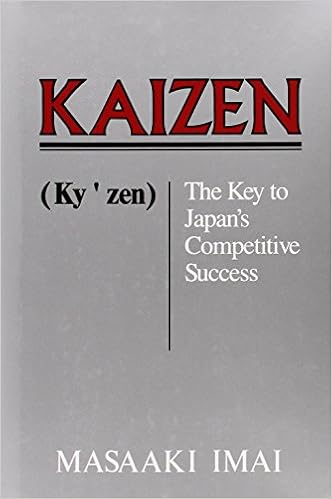
Kaizen: The Key To Japan's Competitive Success Download Free (EPUB, PDF)

For the professional manager or student of management, a comprehensive handbook of 16 Kaizen management practices that can be put to work. KAIZEN uses more than 100 examples in action and contains 15 corporate case studies.

Hardcover: 260 pages
Publisher: McGraw-Hill Education; 1 edition (November 1, 1986)
Language: English
ISBN-10: 007554332X
ISBN-13: 978-0075543329
Product Dimensions: 6.5 x 1.2 x 9.3 inches
Shipping Weight: 1.3 pounds
Average Customer Review: 4.6 out of 5 stars See all reviews (23 customer reviews)
Best Sellers Rank: #124,959 in Books (See Top 100 in Books) #16 in Books > Business & Money > International > Exports & Imports #44 in Books > Engineering & Transportation > Engineering > Industrial, Manufacturing & Operational Systems > Manufacturing #86 in Books > Textbooks > Business & Finance > International Business

1. Japan has gained world economic power through five phases: a) large-scale absorption of technology imported from the US. b) A productivity-drive that strongly supported mechanization, automation, and robotic usage. C) A countrywide quality improvement devotion, set forth by Dr. Demming. D) A great degree of manufacturing flexibility. E) Adoption of a multinational corporation partnerships and structures (global standard component specifications).2. Worker suggestions are an important feedback component in Japanese management. Management works hard to consider worker suggestions. It is not uncommon for management to spend a whole day listening to presentations of activities by Quality circles. The central idea involves listening to improve process and rewards for results.3. Japanese management focuses on standards. Worker suggestions lead to implementation of the suggestion and revising of standards. Toyoda said, "One of the features of the Japanese worker is they use their brains as well as their hands." Improving standards means raising quality levels.4. Intense domestic competition is thought to be the driving force for Japanese companies in overseas market. Japanese compete for larger market share through the introduction of new and more competitive products and by using and improving the latest technologies.5. Why is it important that management establish process-criteria for Quality circles? Quality circles use process criteria to approach their subjects. Process-criteria affect the number of meetings, the amount of participation, and the number of problems solved. Do the Quality circles take into consideration safety, quality, and costs in working out the subject problem?
Kaizen: The Key To Japan's Competitive Success Nora Roberts Key Trilogy CD Collection: Key of Light, Key of Knowledge, Key of Valor Office Kaizen: Transforming Office Operations into a Strategic Competitive Advantage Japan Journeys: Famous Woodblock Prints of Cultural Sights in Japan Matsuri: The Festivals of Japan: With Annotated Plate Section by P.G. O'Neill (Japan Library) Japan Ai: A Tall Girl's Adventures in Japan Stock Market Capitalism: Welfare Capitalism: Japan and Germany versus the Anglo-Saxons (Japan Business & Economics S) Showa 1926-1939: A History of Japan (Showa: A History of Japan) Showa 1953-1989: A History of Japan (Showa: A History of Japan) Showa 1944-1953: A History of Japan (Showa: A History of Japan) Showa 1939-1944: A History of Japan (Showa: A History of Japan) The Power of Broke: How Empty Pockets, a Tight Budget, and a Hunger for Success Can Become Your Greatest Competitive Advantage Gemba Kaizen: A Commonsense Approach to a Continuous Improvement Strategy, Second Edition The Kaizen Pocket Handbook LEAN: Lean Bible - Six Sigma & 5S - 3 Manuscripts + 1 BONUS BOOK (Lean Thinking, Lean Production, Lean Manufacturing, Lean Startup, Kaizen) The Toyota Kaizen Continuum: A Practical Guide to Implementing Lean Creating a Kaizen Culture: Align the Organization, Achieve Breakthrough Results, and Sustain the Gains Kaizen Assembly: Designing, Constructing, and Managing a Lean Assembly Line Diversity at Kaizen Motors: Gender, Race, Age, and Insecurity in a Japanese Auto Transplant The Kaizen Event Planner: Achieving Rapid Improvement in Office, Service, and Technical Environments



